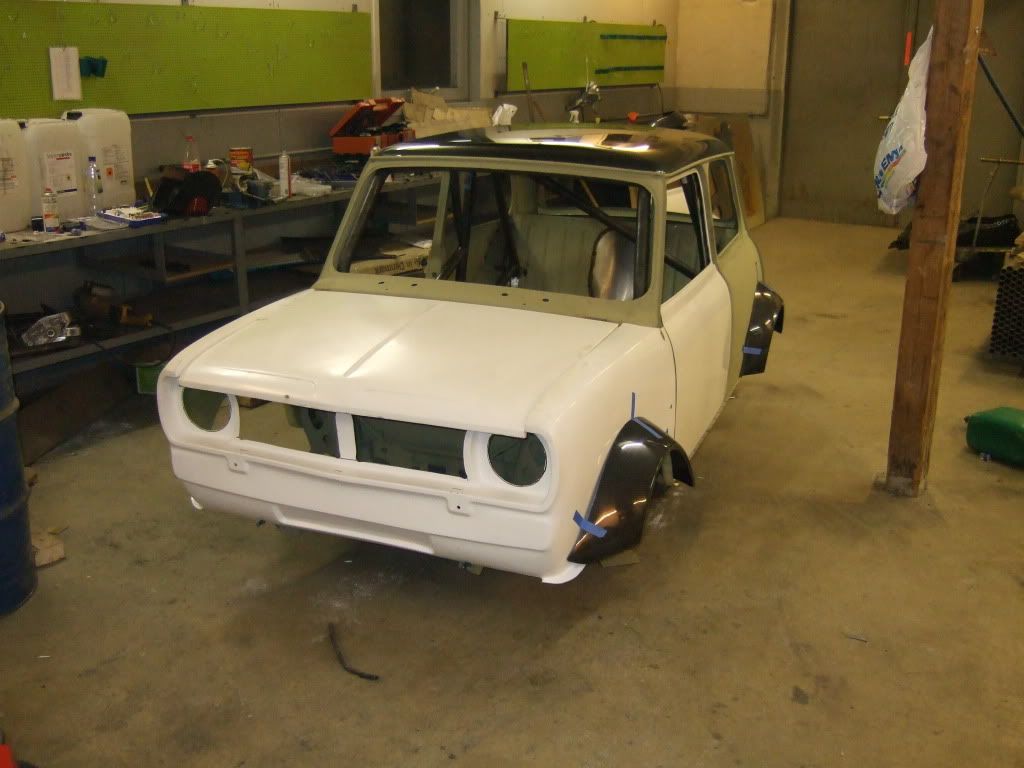| Page: |
| Home > Show Us Yours! > Project "Marginal gains..." | |||||||
 690 Posts Member #: 9962 Post Whore |
18th Dec, 2016 at 11:16:17am
On 17th Dec, 2016 stt said:
I have a friend who is a prototype engineer for a well known brake company, I can ask him to see what the lightest calipers he can make are, Caparo? Thanks very much that would be interesting for both this 10" setup and for the 13" setup, for the 10" I'd happily use a 2 pot ally caliper, there used to be an ally (Girling?) 2 pot caliper back in the day I think, the big problem is the radial clearance for the 10" rosepetal. On 18th Dec, 2016 miniminor63 said:
Thanks. The reason I asked is because i know that the kad hubs have non std balljoint placement/angles at least. That sounds vaguely familiar, do you have any idea what the difference is, I know they only use the 8.4" type drive flange, is it a roll centre change or steering axis, I can enquire directly next week just for interest Cheers |
||||||
|
224 Posts Member #: 9987 Senior Member Amsterdam |
18th Dec, 2016 at 12:24:55pm
Just to add, the lightest caliper isn't always best when braking performance is concerned...I have heard people comment they could see their Minisport calipers flex when having a friend press the brake pedal.
Edited by Evoderby on 18th Dec, 2016. |
||||||
 690 Posts Member #: 9962 Post Whore |
18th Dec, 2016 at 02:36:56pm
Firstly, yes I agree 100% the lighter caliper wont necessarily be the best as far as stiffness / pedal feel etc goes...
Edited by Aubrey_Boy on 18th Dec, 2016. |
||||||
 1849 Posts Member #: 672 The oversills police Oslo, Norway |
18th Dec, 2016 at 03:14:19pm
Std hub and kad hub for comparison. Sorry the arms are on the KaD one, did not want to disassemble |
||||||
 690 Posts Member #: 9962 Post Whore |
18th Dec, 2016 at 03:40:45pm
Thanks very much for taking the time to photograph them together, very interesting more difference than I expected, I see you have the lower ball joint 'extension' - is that a KAD part? Looks like ally? Have you done a test with and without the LBJ extension? Feel any difference?
Edited by Aubrey_Boy on 18th Dec, 2016. |
||||||
 1849 Posts Member #: 672 The oversills police Oslo, Norway |
18th Dec, 2016 at 04:46:44pm
Hi. Happy to be of assistance. The extension is ally, from KAD. Not done much testing at all with this unfortunately.
Edited by miniminor63 on 18th Dec, 2016. |
||||||
 690 Posts Member #: 9962 Post Whore |
18th Dec, 2016 at 05:54:30pm
I didn't know this was your build, I have plenty of photos from your build on my laptop as inspiration.... shame you didn't get to race it around some of Sweden's lovely circuits... Anderstorp being my favourite, you should do a track day tour with it finished!
|
||||||
|
224 Posts Member #: 9987 Senior Member Amsterdam |
18th Dec, 2016 at 07:29:47pm
That inspired me to do some further reading on the subject, you're indeed right.....learning all the time, thanks!
On 18th Dec, 2016 Aubrey_Boy said:
Firstly, yes I agree 100% the lighter caliper wont necessarily be the best as far as stiffness / pedal feel etc goes... Very likely that your standard 'S' caliper will deflect less than any of the 4 / 6 pots on offer, not just the material properties difference but mainly the size of the bridge / opening with a 2 pot having less of an opening compared to 4 / 6 pots etc. So if caliper stiffness is your priority stick with the 'S' caliper. As with any component it's the balance of stiffness:weight and strength:weight which we are willing to make However 7075 wont offer as much (if any) of a reduction in deflection over 6082 as you think when all else is equal, deflection in a materials elastic / linear region is determined by material stiffness and this is given by the various measured moduli a material has, using the data you linked to it gives: Elastic Modulus is 72 GPa for both (A typical stiffness indicator) Shear modulus is 27 vs 26 Gpa for 7075 over 6082 (3.8%) Unless massively overpressured the higher strength that 7075 gives wont really show in the caliper behaviour and even then it's related to the plastic failure. Any properly designed caliper should be way below it's chosen materials yield / failure point. Considering the 15% weight penalty quoted for 7075 you could probably have a stiffer caliper from 6082 by putting material back in say 10% more and still be lighter. It's very common that people think stiffness and strength are the same, T45 is a good example, a T45 cage is no stiffer than a good quality steel cage of the same dimensions, so the car will handle the same as far as any added torsional or bending stiffness either cage gives, but T45 will take a bigger wack to permanently bend or fail it in a crash. Cheers |
||||||
 690 Posts Member #: 9962 Post Whore |
18th Dec, 2016 at 08:33:17pm
No problem,
Edited by Aubrey_Boy on 5th Jul, 2017. |
||||||
|
224 Posts Member #: 9987 Senior Member Amsterdam |
19th Dec, 2016 at 07:00:04pm
Again thanks, very insightful! |
||||||
|
510 Posts Member #: 1592 Smart Guy! mainland europe near ze germans |
20th Dec, 2016 at 08:31:27pm
So cast irn is probably not all that bad then. At least it's stiff.
That sir, is not rust, it is the progressive mass reduction system
|
||||||
 690 Posts Member #: 9962 Post Whore |
20th Dec, 2016 at 08:59:15pm
Yeah cast iron can be good using the higher Modulus stuff...
Edited by Aubrey_Boy on 20th Dec, 2016. |
||||||
|
Forum Mod 10979 Posts Member #: 17 ***16*** SouthPark, Colorado |
20th Dec, 2016 at 09:54:33pm
How stiff do you need stuff to be?
On 17th Nov, 2014 Tom Fenton said:
Sorry to say My Herpes are no better Ready to feel Ancient ??? This is 26 years old as of 2022 https://youtu.be/YQQokcoOzeY |
||||||
 690 Posts Member #: 9962 Post Whore |
20th Dec, 2016 at 10:25:49pm
On 20th Dec, 2016 TurboDave16V said:
How stiff do you need stuff to be? If I had a caliper that was borderline acceptable at 6061-t6, jumping to 7075 would not be my first choice; moreover I'd figure out what to do differently with the base design. My real concern is that 7075 unless I bought it from a company I trusted like Alcoa or Kaiser AND had cert papers, is that you really, really don't know what the real mechanical properties are. This is why any Chinese shop on alibaba can make a billet doohickey, but a shop making the same visual component, allegedly in the same base material, will be hugely more expensive from a shop that uses reputable sourced materials... That said, everyone seeks to like the "billet" H beam rods that clearly are made in the China... Assuming you have a start point, stuff only needs to be as stiff such that you don't notice a reduction in your measure of 'performance' when reducing its weight, but that differs with your intended use, if you only require your car to stop at the end of a drag strip once every half hour before the road runs out, irrespective of whether the brake feel might be slightly worse than a 'standard' heavier part then the weight saving is more important, if you race at Le Mans and require a consistent brake pedal / feeling 1000's of times in the race then confidence is more important and carrying a bit more weight and hence stiffness is preferred. I'm not favouring any material just stating that the moduli will dictate it's stiffness not it's quoted 'strength' It goes without saying material always has to be from a trusted, certified source. Edited by Aubrey_Boy on 21st Dec, 2016. |
||||||
 690 Posts Member #: 9962 Post Whore |
23rd Dec, 2016 at 06:33:06pm
|
||||||
 6744 Posts Member #: 828 Post Whore uranus |
23rd Dec, 2016 at 07:58:27pm
in case it helps, here's my g forces for a 13.28 and 13.13 run overlaid ..
Edited by robert on 18th Oct, 2017. Medusa + injection = too much torque for the dyno ..https://youtu.be/qg5o0_tJxYM |
||||||
 690 Posts Member #: 9962 Post Whore |
23rd Dec, 2016 at 08:21:24pm
Hi Robert,
|
||||||
 6744 Posts Member #: 828 Post Whore uranus |
23rd Dec, 2016 at 09:30:10pm
remember that's on falken tyres with no lsd and a fair bit of one wheel wheelspin in 1st and 2nd gear .
Medusa + injection = too much torque for the dyno ..https://youtu.be/qg5o0_tJxYM |
||||||
 690 Posts Member #: 9962 Post Whore |
23rd Dec, 2016 at 09:59:04pm
Cheers Robert,
Edited by Aubrey_Boy on 23rd Dec, 2016. |
||||||
 2909 Posts Member #: 83 Post Whore Glasgow, Scotland |
23rd Dec, 2016 at 11:11:30pm
So are we at a 10%gain or 50%gain in traction? Sorry im struggling a bit to digest the figures, im reading it as a 10%gain in relative downforce on the front tyres, not sure thats worth it :/
Edited by evolotion on 23rd Dec, 2016. turbo 16v k-series 11.9@118.9 :)
|
||||||
 690 Posts Member #: 9962 Post Whore |
24th Dec, 2016 at 01:27:42am
Sorry if I wasn't very clear, what I am saying is that without wheelie bars on a 0.75g launch you lose 20% of your tyre vertical force (Down force as you put it)
Edited by Aubrey_Boy on 24th Dec, 2016. |
||||||
|
21 Posts Member #: 9627 Member |
28th Dec, 2016 at 01:31:09am
Where's the updates from your work on it over Boxing Day 😜 |
||||||
|
Forum Mod 10979 Posts Member #: 17 ***16*** SouthPark, Colorado |
28th Dec, 2016 at 04:57:38am
The wheelie bars I've seen up close on a Honda stateside had heavy springs, and are somewhat flexible. They don't impart so much force that the rear wheels lift, but probably remove 25-35" % of static weight off the rear axle. They of course also raise once out of the gate, to reduce rolling friction. I'd have thought the benefit was very much worth it though. On 17th Nov, 2014 Tom Fenton said:
Sorry to say My Herpes are no better Ready to feel Ancient ??? This is 26 years old as of 2022 https://youtu.be/YQQokcoOzeY |
||||||
 690 Posts Member #: 9962 Post Whore |
28th Dec, 2016 at 07:05:08pm
On 28th Dec, 2016 stt said:
Where's the updates from your work on it over Boxing Day 😜 I wish... Hopefully I'll get in the garage for a few hours tomorrow, I'd love to have the seat back welded to the inner arches but I usually get half of what I plan done, so may just get it's shape and returns done ready to mount it. Then the boot floor, whatever I finally decide to do with that Cheers |
||||||
 6744 Posts Member #: 828 Post Whore uranus |
28th Dec, 2016 at 09:04:34pm
On 23rd Dec, 2016 Aubrey_Boy said:
Cheers Robert, What do you think is the maximum accel on a drag lauch you've seen for a fwd mini? gosh no idea..... i would guess toms force car would be worth doing a sim on with the numbers from its real world runs as data ? Edited by robert on 18th Oct, 2017. Medusa + injection = too much torque for the dyno ..https://youtu.be/qg5o0_tJxYM |
||||||
| Home > Show Us Yours! > Project "Marginal gains..." | |||||||
|
|||||||
| Page: |



